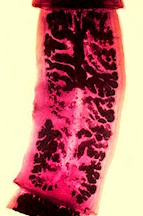Cysticercus cellulosae, the pork bladder worm, is the larval stage (cysticercoid, metacestode) of Taenia solium, a human tapeworm parasite that has swine and wild boars as intermediate hosts.
Cysticercus cellulosae occurs worldwide, mainly in poorly developed rural regions with insufficient sanitary conditions.
The disease caused by this and other cysticercoids is called cysticercosis.

This parasite does not affect dogs, cats, horses, cattle, sheep, goats or poultry.
Are animals infected with Cysticercus bovis contagious for humans?
YES. Humans can become infected with Taenia solium tapeworms after eating raw or insufficiently cooked pork or other tissues from infected swine. Simple contact with infected pigs or their feces is not contagious. See the life cycle below.
You can find additional information in this site on the general biology of parasitic worms and/or tapeworms.
Final location of Cysticercus cellulosae
Cysticercus cellulosae are found in several parts of the pig's body, mostly in muscles and subcutaneous tissue, but also in other organs (brain, heart, liver, etc.). The predilection site of adult tapeworms in their human hosts is the small intestine.
Anatomy of Cysticercus cellulosae
In pigs Cysticercus ovis appears as small whitish cysts filled with fluid (bladder worms) that contain an immature worm. They are up to 20 mm long and 6 mm wide. Infected pork ("pearly pork") can have dozens of such cysts. Several months after infection the cysts die and become calcified.
Visit the page on Taenia species for additional information of the anatomy of adult Taenia tapeworms.
Life cycle and biology of Cysticercus cellulosae
As all tapeworms, Taenia solium has an indirect life cycle, with humans as final hosts, and swine and wild boars as intermediate hosts.
Pigs become infested when ingesting food or water contaminated with eggs or gravid segments of Taenia solium. Contamination of pig feed can occur through undue defecation of humans in the pastures or stables, but also indirectly through irrigation with contaminated human sewage, or using contaminated human feces as fertilizers.
Once ingested by pigs the young larvae hatch out of the eggs in the gut, migrate through the intestinal wall, and reach the blood stream. They are transported to a muscle or elsewhere, where they encyst. The cysts need 2 to 3 months to complete development. The cysts may remain infective for humans for up two years.
Humans become infected when eating raw or insufficiently cooked pork contaminated with cysts. Once in the human gut, the cysts release the young tapeworm, which attaches to the gut's wall and start producing segments. Within 7 to 8 weeks the tapeworms mature and start shedding eggs (prepatent period).
Harm caused by Cysticercus cellulosae, symptoms and diagnosis
Cysticercus cellulosae is not pathogenic for swine and usually the infection causes no clinical signs, unless a vital organ (e.g. the heart) is massively infected, which is very unusual. In case of massive infections muscle stiffness has been reported. However, infections have a substantial economic impact because the whole carcass is condemned at slaughter. This is needed to avoid people becoming infected when consuming pork insufficiently cooked. So far diagnosis on pigs is only possible post-mortem after carcass examination.
Human infections with Taenia solium are often very serious and even lethal. Cysticercoids in pork ingested by humans release the young tapeworms in the gut, which attach to the gut's wall and start producing segments. This is mostly not very harmful for humans. However, under certain conditions the larvae migrate through the gut's wall of its human host, reach the blood stream and are transported elsewhere in the body, to produce cysticercoids, very much like in the intermediate hosts. If such cysticercoids affect the brain or other vital organs, they are often lethal.
Prevention and control of Cysticercus cellulosae
Cysticercus cellulosae is not pathogenic for pigs, but prevention is important to avoid transmission to humans and carcass condemnation at slaughter.
As a general rule, cysticercosis is usually not a problem in modern industrial pig production, but can occur in traditional farming and pigs kept outdoors. Best prevention consists in avoiding the contamination of swine feed or water with human feces that may contain tapeworm eggs. This requires providing adequate latrines for workers, following strict hygiene measures (e.g. thorough hand washing) when handling animal feed, and ensuring that sewage water used for pasture irrigation is not contaminated. It must be considered that the eggs may remain infective in the feed after silage or other processing of hey or fodder (pelletizing, fermentation, etc.).
The regular use of anthelmintics is usually not indicated to prevent swine infections with Cysticercus cellulosae. There are reports that albendazole and praziquantel are effective, but often at dose significantly higher than the therapeutic one, and results can be unreliable.
Several classic livestock anthelmintics such as macrocyclic lactones (e.g. ivermectin, selamectin, etc.), levamisole, tetrahydropyrimidines (e.g. pyrantel, morantel) and piperazine derivatives are not effective at all against Cysticercus cellulosae or whatever adult tapeworm or cysticercoid.
There are so far no vaccines that would protect swine against Cysticercus cellulosae. To learn more about vaccines against parasites of livestock and pets click here.
Biological control of Taenia tapeworms respectively Cysticercus cellulosae (i.e. using its natural enemies) is so far not feasible.
You may be interested in an article in this site on medicinal plants against external and internal parasites.
Resistance of Taenia spp to anthelmintics
So far there are no reports on resistance of Taenia spp, respectively Cysticercus cellulosae to anthelmintics.
This means that if an anthelmintic fails to achieve the expected efficacy, chance is very high that either the product was unsuited for the control of Cysticercus cellulosae, or it was used incorrectly.
|
Ask your veterinary doctor! If available, follow more specific national or regional recommendations for Cysticercus cellulosae control. |